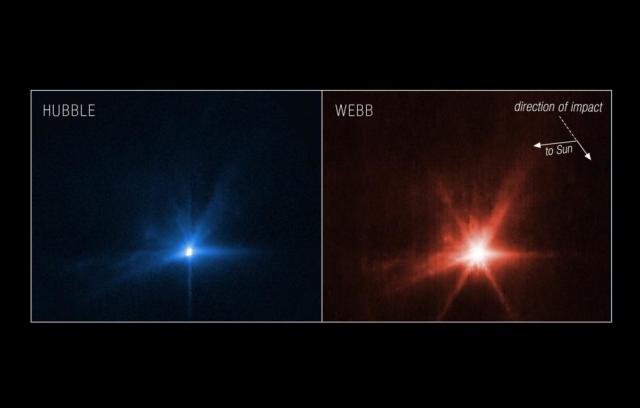The first detailed photos of the collision point will appear in 2026, after the launch of the Hera missionTASS, September 29.
The Hubble and James Webb orbiting telescopes received the first photos of the double asteroid Didymus after one of its halves collided with the DART probe on Tuesday, which presumably led to a change in the course of the celestial body's movement. This was reported on Thursday on the official website of the James Webb telescope.
"The James Webb Telescope received photos of Didim a few hours before the collision and after the impact of the Dart probe. The resulting images show several narrow cones of dust and particles ejected from the surface of the asteroid at the time of impact of the spacecraft. In turn, the images from Hubble indicated that the asteroid's brightness increased three times after the impact," the report says.
The Dart probe is part of the Aida project initiated by ESA and NASA in May 2012. It involves sending two small spacecraft, named DART and Hera, to the asteroid Didim. The first crashed into an asteroid at a speed of about 6.5 kilometers per second earlier this week, and the second vehicle will arrive at the asteroid in 2026 to study the consequences of this collision.
The first scientific data, as noted by the scientific teams of Hubble and James Webb, were obtained by astronomers 15 minutes after Dart collided with the surface of the larger half of Didymus. To get these photos, the pilots of both missions had to develop special algorithms that allowed them to track the movement of an asteroid that moves very quickly across the sky compared to the stars.
The first photos of the "space accident"In total, "James Webb" and "Hubble" observed Didymus for five hours after his collision with the Dart probe, which allowed scientists to obtain several dozen images of this celestial body and comprehensively study the effects of impact on its surface.
These studies were carried out both in the visible and infrared range of electromagnetic waves.
According to the researchers, the photos they obtained indicate that the asteroid's brightness temporarily increased by about three times after the collision, which is due to the presence of a "plume" of a large number of dust particles and small fragments of the asteroid, which are now following Didymus. This cluster still prevents scientists from seeing the surface of the celestial body, as well as determining whether the orbit of the second half of the asteroid, which was named Dimorph in June 2020, has shifted.
In the next three weeks, the Hubble and James Webb research teams plan to conduct ten more sessions of observations of Didymus and Dimorph. These measurements will help scientists understand how the dust cloud dissipates after collisions of objects in space, as well as get the first accurate information about how successfully the Dart probe fulfilled its main task.
In October 2024, the Hera mission will be launched into space, which will approach the asteroid in 2026 and receive the first detailed photos of the collision point of Dart and Didymus. The information obtained will be critically important for working out further plans to create systems capable of protecting the Earth from asteroid impacts.

